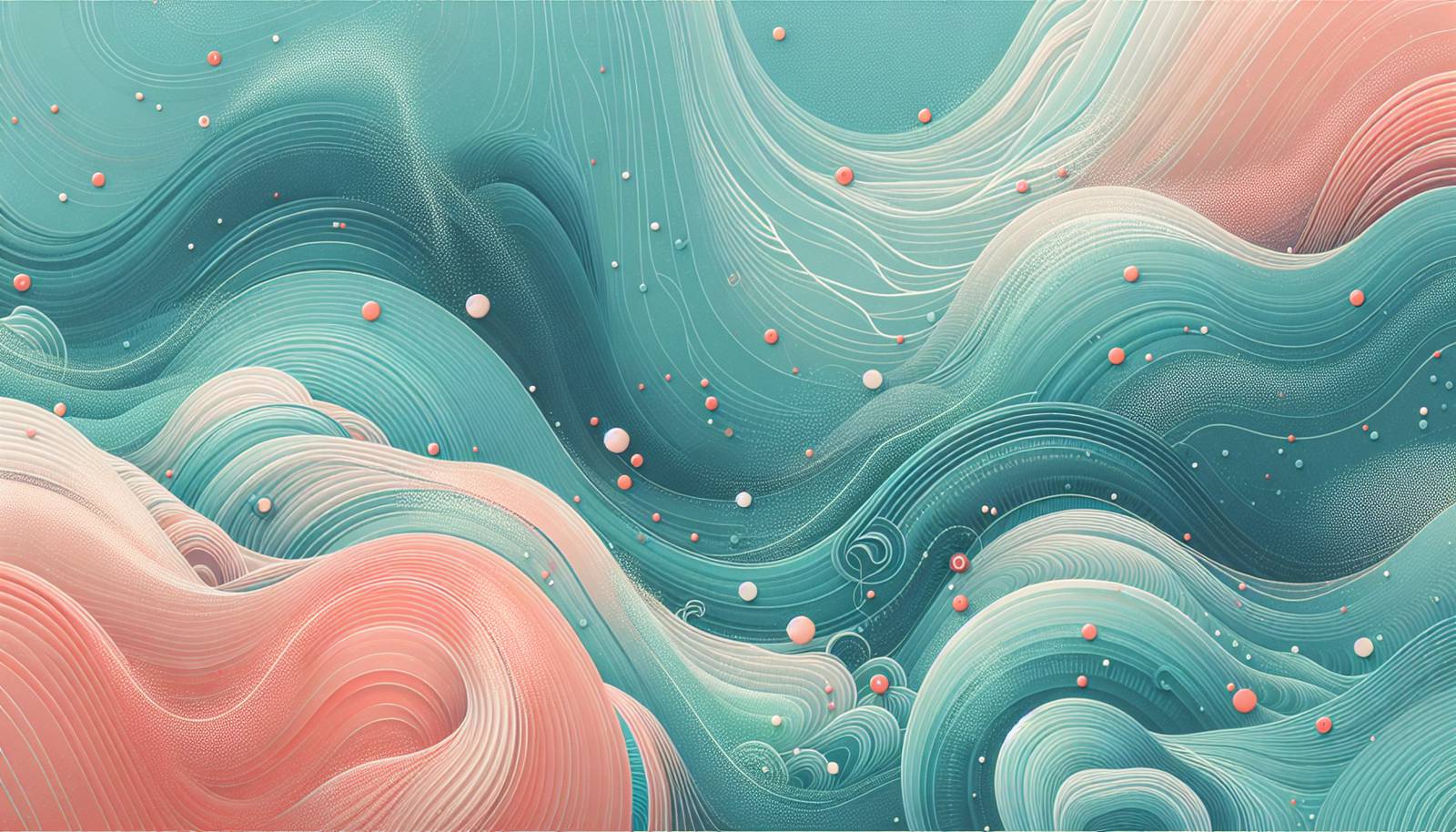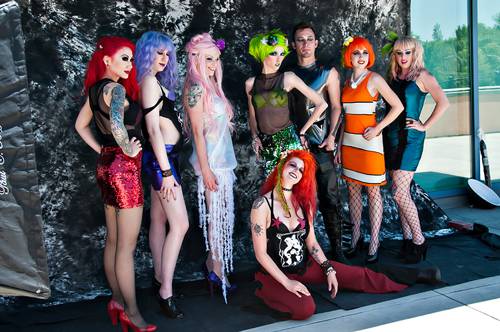
FAQ About The Influence of Seapunk Aesthetic on Digital Art

What is Seapunk aesthetic?
Seapunk is a visual and musical movement that originated around 2011, characterized by its unique blend of ocean-inspired elements with retro digital graphics reminiscent of early Web 1.0 aesthetics. This includes repetitive use of motifs such as dolphins, waves, and aquatic colors interwoven with 3D textures, pixelated graphics, and nostalgic 90s internet iconography. The movement encompasses music, digital art, and fashion, incorporating elements like brightly colored hair, virtual reality, and cybernetic themes.

How did Seapunk start?
Seapunk began as a social media joke but quickly evolved into a full-fledged subculture. It is often credited to DJ and musician Lil Internet, who coined the term 'Seapunk' in a tongue-in-cheek Twitter post in 2011. This playful nod to the combination of ocean motifs and punk aesthetics caught on with artists and musicians who started creating works that embodied these themes, eventually spreading into digital art and fashion.

How has Seapunk influenced digital art?
Seapunk has significantly influenced digital art by encouraging artists to explore dreamy, surreal, and oceanic themes within the context of digital spaces. Artists incorporate Seapunk's aesthetic using vibrant turquoise and aqua colors, glitch art techniques, and nostalgic 3D graphics. This influence extends to online platforms where digital artists use this style to create immersive, thematic works that capture both the serenity and chaos of ocean life, blending them with digital culture tropes.

What are some common motifs in Seapunk art?
Seapunk art is recognized for its distinctive motifs that combine 90s digital art with oceanic imagery. Common symbols include dolphins, palm trees, seashells, and waves, often incorporated with cyber-themed graphics like holograms, 3D models, and pixelated images. These elements are typically presented in bold, neon colors, often with an iridescent or metallic finish to mimic underwater themes.

Which music videos have been influenced by Seapunk?
Seapunk has influenced several mainstream music videos, most notably Azealia Banks' "Atlantis" and Rihanna's "Diamonds", which incorporate the movement's distinct oceanic and digital aesthetics. These videos utilize colorful, surreal visuals, incorporating CGI ocean scenes, dolphins, and other maritime imagery that align with the Seapunk theme.

Why did Seapunk become popular in digital art communities?
Seapunk resonated with digital art communities due to its unique blend of nostalgia for the early internet era and its innovative use of oceanic themes. The aesthetic's distinctive, easily recognizable look provided artists and creators a fresh palette to experiment with new forms of digital expression. Moreover, its roots as an online meme gave it viral potential, allowing it to quickly spread and be embraced by internet subcultures.

Is Seapunk still relevant in digital art today?
While Seapunk as a distinct movement has waned, its influence persists in digital art and online aesthetics. Elements of Seapunk can still be seen in contemporary works, especially in those that seek to evoke nostalgia or explore cyber-oceanic themes. Artists continue to draw inspiration from Seapunk's playful mashup of aquatic imagery and retro digital technology, keeping its spirit alive in modern art forms.

How does Seapunk relate to other internet subcultures?
Seapunk shares similarities with other internet subcultures like vaporwave and cyberpunk, all of which offer unique critiques of modern technology and nostalgia for past aesthetics. These movements overlap in their retro visual styles, often characterized by a mix of digital futurism and nostalgia. Seapunk’s playful and surreal qualities complement the more serious or satirical tones of other movements, creating a broad tapestry of digital subcultural expression.

What platforms helped Seapunk spread its influence?
Seapunk heavily utilized social media platforms such as Twitter and Tumblr to spread its influence. These platforms allowed for rapid sharing and collaboration among artists, which helped nurture and disseminate the aesthetic. Moreover, platforms like SoundCloud and Bandcamp enabled musicians to explore and expand on Seapunk’s themes with electronic and experimental music, further broadening its reach.

Can the principles of Seapunk be applied to traditional art forms?
Yes, while Seapunk heavily relies on digital platforms, its underlying themes of oceanic elements and retro digital aesthetics can be translated into traditional art forms as well. Artists working in media such as painting, sculpture, or mixed media can incorporate Seapunk motifs like dolphins, neon colors, and layering techniques to evoke the same whimsical and surreal qualities found in digital Seapunk art.

Who are some notable artists associated with Seapunk?
Notable artists associated with Seapunk include the likes of Azealia Banks in music, alongside visual artists such as Lil Internet, who helped popularize the aesthetic. Other musicians and producers, like Unicorn Kid, have also contributed significantly to the Seapunk aesthetic, particularly in music. These artists create work that embodies the playful, ocean-meets-digital theme that defines the movement.

What role do colors play in Seapunk art?
Colors play a vital role in Seapunk art, as they help convey its aquatic themes and nostalgic connection to early digital aesthetics. The color scheme typically includes shades of turquoise, aqua, and sea greens, often paired with neon pinks and purples. These colors are instrumental in creating the ethereal, underwater feel that is central to Seapunk, simultaneously evoking elements of the past digital era.

What types of media are commonly used in creating Seapunk art?
Seapunk art spans multiple types of media, but is predominantly showcased through digital platforms. Commonly used media include 3D modeling and digital illustrations, which are shared online. Additionally, digital artists often use animated GIFs, video art, and virtual reality environments to immerse audiences in Seapunk's distinctive atmosphere. Musicians integrate Seapunk aesthetics through album art and music videos, further adding to its versatile nature.

How do Seapunk aesthetics influence modern fashion?
Seapunk aesthetics have infiltrated the world of fashion, often characterized by bold, colorful prints and ocean-themed accessories such as seashell jewelry and holographic fabrics. Clothing often features vibrant colors and digital graphics that mirror Seapunk's art style. This movement encourages adventurous, youthful expression in fashion, embracing futuristic cyber themes alongside nostalgic references to the 90s.

Are there any controversies associated with Seapunk?
Like many subcultures that start out as niche, Seapunk has faced issues with mainstream appropriation and commercialization. Some members of the original community have expressed concerns that major artists or brands might dilute the movement's distinct aesthetic for profit without acknowledgment. Such situations raise discussions about the ownership and evolution of digital art movements in a rapidly changing media landscape.

What is the difference between Seapunk and Vaporwave?
While both Seapunk and Vaporwave draw heavily from 90s digital culture, their aesthetics and themes differ. Seapunk focuses more on aquatic motifs combined with colorful, playful visuals reminiscent of early internet graphics. In contrast, Vaporwave often includes more commercial elements from the 80s and 90s, combined with a critique of consumerism and capitalism. Vaporwave's palette tends to be more pastel with a proclivity for dreamy and melancholic tones compared to Seapunk's vibrant hues.

How does Seapunk celebrate digital nostalgia?
Seapunk celebrates digital nostalgia by reviving artistic elements from the early internet era, such as pixelated graphics, neon colors, and 3D renderings reminiscent of primitive computer graphics. It taps into the collective memory of browsing the web in the 90s, using this nostalgic imagery to evoke a sense of playfulness and fantasy. This homage to a bygone digital era is central to Seapunk's appeal and continues to inspire new creative directions within digital art.

How can one start creating Seapunk art?
To start creating Seapunk art, one can begin by studying the primary elements that define the aesthetic, such as oceanic motifs, retro digital visuals, and vibrant color schemes. Artists can experiment with digital tools and software like Adobe Photoshop or Blender to create 3D models and layered visuals that capture the spirit of Seapunk. Engaging with online communities and platforms that focus on Seapunk themes can also provide inspiration and collaborative opportunities.

What are the key elements of Seapunk music?
Seapunk music generally features an eclectic mix of electronic, pop, and house influences, often layered with sound elements that evoke the ocean, such as waves or aquatic animals. The music usually carries an upbeat rhythm, utilizing synths and retro-futuristic sounds that mirror the digital origins of Seapunk art. This creates an immersive soundscape that complements the visual elements of Seapunk, enhancing its artistic and sensory experience.

Has Seapunk influenced any other art movements?
Seapunk has influenced subsequent digital art movements by reinforcing the idea of thematic mashups and the nostalgia-driven exploration of past internet culture. Elements of its ocean-meets-digital aesthetic can be seen in newer subcultures that also draw from the wealth of visual and musical history on the internet, inspiring artists to continue experimenting with the convergence of retro technologies and nature-inspired motifs.
